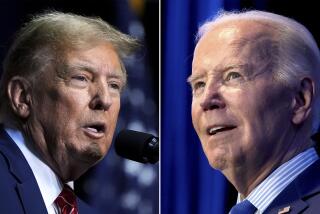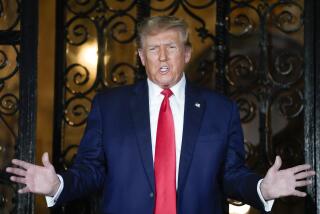Furors around Trump don’t change many minds, but one group has shifted
After a week packed with talk of constitutional crises, trade brinksmanship and foreign confrontations, let’s pause to ask whether the high-decibel headlines have changed any voters’ minds.
The short answer: not many, but an important few.
In this highly partisan era, most Americans have firmly set views of party leaders, and of President Trump especially. But some voters do shift, and the outcome of the 2020 election could swing with them. This week, we got a closer look at who those swing voters are.
Sign up for the Essential Politics newsletter »
THE OBAMA-TRUMP VOTER
Americans’ views of Trump have been remarkable in two ways: No modern president’s approval dropped so low so quickly, and none has remained on such a firm plateau.
Attitudes toward Trump have fluctuated a bit at key moments — dropping a few points during episodes including the mass separation of migrant families at the southern border, the effort to repeal the Affordable Care Act and the president’s response to the violent neo-Nazi demonstration in Charlottesville, Va.; rising slightly in between.
The changes are small, however. Overall, Trump’s admirers love him, his detractors loathe him, and few remain neutral.
Within that pattern, at least one important group has shifted, according to the latest data released by the Voter Study Group, a nonpartisan research consortium.
Based on a series of polls that began in 2016 and have continued through Trump’s presidency, the research finds that about 85% of Americans have consistently held the same view of Trump. Almost half have consistently disliked him; just over one-third have consistently liked him.
It’s the shifting views of the remaining 15% which account for any changes in Trump’s standing. Importantly, if one adds up all the people who have ever expressed a positive view of Trump in one of the surveys, it comes to just 49%.
If the 36% who consistently have a favorable view of Trump represents the floor for his approval, that 49% may represent his ceiling, Robert Griffin, the study group’s research director, wrote.
The group that has shifted its view the most are those who cast ballots for Trump in 2016 after having previously voted for President Obama in 2012.
Those Obama-Trump voters made up about 1 in 8 of Trump’s voters in 2016 and more than accounted for his margin of victory in key states. They are mostly blue-collar, white voters and are concentrated in the big industrial states that were key to Trump’s victory.
Most of the Obama-Trump voters have remained favorable toward Trump. That’s not surprising; research has shown that many of them are Republican-leaning. Their votes for Obama over Mitt Romney marked the aberration for many of them, not their support of Trump.
But Trump has suffered a significant erosion nonetheless. In 2016, 85% of Obama-Trump voters held a favorable view of Trump; now 66% do. Younger people in the group seem most likely to have moved away from Trump, survey evidence suggests.
When former Vice President Joe Biden launched his campaign in a union hall in Pittsburgh, it was those Obama-Trump voters and their potential to deliver Wisconsin, Michigan and Pennsylvania that he had in mind.
THE TURNOUT DILEMMA
But winning over blue-collar, white voters who once voted for Obama isn’t the sole concern for Democrats. They also have to worry about turning out their own core supporters.
On that point, too, new data has added to the picture — providing more detail on exactly how the Democrats won back control of the House in the 2018 midterm election.
Fewer voters show up for midterm elections than for presidential contests. In recent years, the midterm drop-off has usually hurt Democrats. In 2018, the opposite was true.
Votes cast by whites without a college education dropped by almost 20% in 2018 compared with 2016, according to data from TargetSmart, a Democratic firm that compiles voter data. By contrast, the votes of whites with a college education dropped by just 2.6%, the smallest drop of any group in the electorate, according to Tom Bonier, the firm’s chief executive.
Trump strongly motivated his blue-collar, white supporters in 2016. Nearly everything he’s done since has been aimed at keeping them stirred up. That’s part of what accounts for comments like his call Thursday for former Secretary of State John F. Kerry to be prosecuted for allegedly violating the Logan Act.
Trump wasn’t able to motivate enough of his backers to show up in 2018, and a key question for 2020 will be how much they rally when his name is back on the ballot. It’s important to remember that Trump’s victory margins in the key states were tiny, so he can’t afford to lose much.
But an equally important question will be Democratic turnout. In the midterm, turnout of voters younger than 30 nearly doubled, compared with the previous midterm election, according to state-by-state voter data analyzed by TargetSmart.
California led the way in that increase, helping account for the Democrats’ near-sweep of the most-contested congressional districts in the state.
As Biden argues he can win back the Obama-Trump voters, his rivals say they would do a better job at motivating young people and minorities.
That argument about what “electability” really means in 2020 was at the heart of the case that Sen. Kamala Harris began making publicly this week during a campaign swing in Michigan, as Melanie Mason wrote. It’s the argument on which the Democratic nomination contest likely will turn.
MUELLER REPORT PHASE TWO
I wrote last week that Trump had strong incentive to continue to ratchet up tensions with Democrats, and, indeed, the White House moved quickly this week to crank things up further.
As Chris Megerian wrote, Trump claimed executive privilege to block release of a more complete version of Robert S. Mueller III’s report of his investigation. The House Judiciary Committee responded by voting to hold Atty. Gen. William Barr in contempt.
As David Savage wrote, both sides are on unclear legal ground. Past clashes between Congress and the executive branch have usually ended with some sort of political compromise, not a definitive court ruling.
This dispute could eventually end up in the courts. So far, however, as Jennifer Haberkorn wrote, House Democrats are taking a long, slow road to confront Trump. Speaker Nancy Pelosi has said she believes Trump is “goading us to impeach him” and has made clear she wants to avoid taking that bait.
The next act in the drama likely will be Mueller’s public testimony. House leaders had been aiming for a May 15 hearing. That date seems likely to slip a bit, but Judiciary Committee Chairman Jerrold Nadler (D-N.Y.) says he expects any delay will be brief.
Some on the party’s left have criticized Pelosi for moving too slowly, but Democratic lawmakers have so far remained fairly unified behind her.
Lawmakers have also been dealing with another divisive internal issue, Haberkorn wrote. Progressives have condemned a policy designed to protect incumbents by discouraging party consultants from working for challengers in primaries.
TRADE WAR ESCALATION — SORT OF
Trump’s tariff hike on Chinese goods took effect in the wee hours of Friday morning, but as Don Lee wrote, the two sides are still talking, and the new tariffs are somewhat illusory for now.
The illusion comes about because the tariffs only apply to goods that left China after midnight Thursday. Since most trade is by ship, the vast majority of those goods won’t arrive in U.S. ports for weeks, giving time for talks to reach an agreement.
As Lee wrote, an all-out trade war would be costly to the U.S. economy, and Trump has strong reason to avoid that.
ROUGH GOING ON FOREIGN POLICY
Part of Trump’s incentive to reach a deal with China is that the rest of his foreign policy hasn’t had much success of late, as Eli Stokols, Noah Bierman, David Cloud and Lee wrote.
The effort to foment a coup in Venezuela appears to have stalled, tensions with North Korea have increased, and Iran has taken steps back toward a nuclear program, as Tracy Wilkinson wrote.
TRUMP AND THE GOP
If you’re looking for a perfect symbol of how Trump has taken over the Republican party, consider Ronna McDaniel. As Bierman wrote, the niece of former GOP nominee and current Utah Sen. Mitt Romney has even dropped Romney from her name as she has sought to demonstrate loyalty to the president.
But that premium on loyalty cuts both ways, as Mark Barabak wrote. In Arizona, the ascendance of Kelli Ward, a conservative and Trump backer, to the head of the state party has many Republicans worried. Ward was a pungent critic of the late Sen. John McCain, and her prominence could alienate voters that the GOP will need as the party tries to hold a Senate seat in 2020.
BIDEN RAISES MONEY IN L.A.
“It is a marathon and we have a long way to go,” Biden told donors at one of three fundraisers he held in L.A., as Melanie Mason reported.
Backers of Sens. Bernie Sanders and Elizabeth Warren have sought to make an issue of rival candidates holding these sorts of big-dollar events, but so far, there’s little evidence that Biden has paid a price in voter support.
Meanwhile, as Doyle McManus wrote, Sen. Cory Booker has placed a campaign bet on gun control, issuing a plan for federal gun registration. The proposal illustrates how far the debate on the Democratic side has shifted on that issue.
CALIFORNIA WINNING ENVIRONMENTAL FIGHTS
The state has filed dozens of lawsuits against the administration on environmental issues and, so far, has an enviable win-loss record, Anna Phillips wrote. Administration officials hope they will fare better as cases move toward the Supreme Court.
The administration this week moved to expand oil and gas drilling in Central California, Phillips wrote. The new policy mostly affects 11 counties — stretching from the Pacific coast to the San Joaquin Valley — with the bulk of the affected land in Fresno, Monterey and San Benito counties.
NEW DEFENSE NOMINEE
Since the resignation of James N. Mattis, the Pentagon has been without a permanent chief for nearly five months, an unprecedented lapse.
Thursday, the White House announced that Trump will nominate Patrick Shanahan, currently the acting secretary. Shanahan is a former Boeing executive and has little military or strategic experience. His ties to Boeing have raised concerns about possible conflicts of interest since his former company is among the Pentagon’s largest contractors.
MORE MOVES TO RESTRICT ASYLUM
Internal documents that Molly O’Toole obtained show a new effort to restrict asylum claims, including having Border Patrol agents conduct some of the initial interviews used to screen applicants. Critics say the moves could politicize an already fraught process.
LOGISTICS
That wraps up this week. Until next time, keep track of all the developments in national politics and the Trump administration at our Politics page and on Twitter @latimespolitics.
Send your comments, suggestions and news tips to politics@latimes.com.
If you like this newsletter, tell your friends to sign up.
More to Read
Get the L.A. Times Politics newsletter
Deeply reported insights into legislation, politics and policy from Sacramento, Washington and beyond. In your inbox three times per week.
You may occasionally receive promotional content from the Los Angeles Times.







